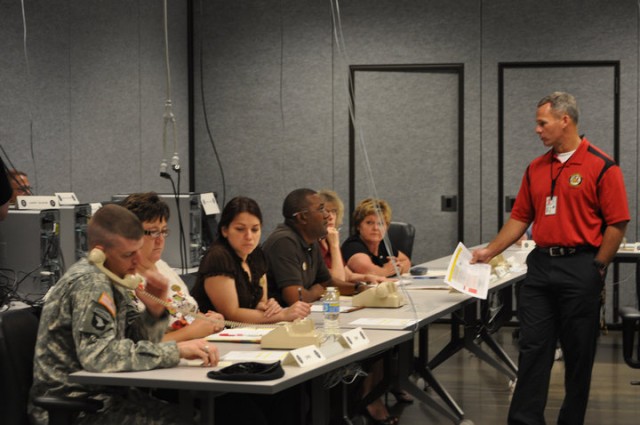
FORT CAMPBELL, Ky. -- Fort Campbell is preparing, not based on everyday likelihoods of an emergency situation, but with the knowledge of its possibility.
Agencies from around the installation are gathering to engage in an exercise that will measure responsiveness in the event of several emergency situations.
Fort Campbell Anti-terrorism Officer, Bobby Atwell, called installation representatives together Wednesday at Kinnard Battle Command Training Center to begin preparing for the upcoming exercise, which will run through multiple scenarios.
Aca,!A"It tests abilities in emergency management function and anti-terrorism function,Aca,!A? Atwell said. Aca,!A"You have to do a little out-of-the-box thinking to ask what might happen.Aca,!A?
For example, Directorate of Public Works, he said, might suddenly have the job of housing a large number of people if a storm causes massive damage.
Everything from transportation to finding shelter for residents would require staff at DPW to find an immediate solution to the situation.
Using the Joint Conflict and Tactical Simulation virtual training and coordinating with the Emergency Operations Center, the aim is to test how well EOC performs in a crisis situation and how well organizations can respond to them.
Preparedness, Atwell said, concerns an agency being able to provide the resources needed in the unlikely event of a crisis.
Aca,!A"The main thing is to keep people informed of whatAca,!a,,cs going on in the process,Aca,!A? he said.
Garrison commanders have required agencies to know their own battle plan should there ever be an emergency weather situation or incident of terrorism.
During a two-day exercise, coordination between BCTC and EOC will show attendees from various installation agencies how to prepare for tornadoes one day, while dealing with a Vehicle-Borne Improvised Explosive Device or active shooter, the next.
Given recent intelligence suggesting a real-world threat directed at Fort Campbell interests in addition to August being Anti-terrorism Awareness Month, the training is timelier than ever.
Aca,!A"There was a specific threat against the installation,Aca,!A? Atwell said Wednesday, declining to mention the specifics.
But currently, he said the on-post threat level remains at Aca,!A"AlphaAca,!A? and there is no need for concern among the population.
Still, he cautioned those in attendance to take care not to confuse training exercises with Aca,!A"real worldAca,!A? situations, especially when communicating with EOC.
Fort Campbell has made preparations to deter that threat, another of the training goals, Atwell said.
Recommendations are not readily shared for public purposes, but simply participating in them ensures that various interests around the installation are ready to respond, should the need arise.
One response in the event of a higher threat level could include the closing of DoD schools on post or possibly suspending training exercises.
Atwell indicated that a potential enemy with a serious threat might be seeking an in-route to the installation via one of the gates.
Our ability to Aca,!A"change postureAca,!A? will show how ready we are for an attack, Atwell said.
The actual training will involve role playing scenarios in which these agency representatives are able to engage with the JCATS virtual program.
Between BCTC and EOC, one location will simulate a situation by way of computer and trainees will plot on a map, their course of action.
Still the biggest thing youAca,!a,,cre doing here is role playing, Atwell said. Aca,!A"You will also learn to use communications in an emergency situation.Aca,!A?
Those in attendance Wednesday were able to familiarize themselves with the program.
Sergeant 1st Class Eric Ebeling serves as operations NCO with DPW and said that WednesdayAca,!a,,cs walk through helped him to see the importance of communication in these scenarios.
Aca,!A"This plays a huge part when you have people working long, 12-hour shifts,Aca,!A? Ebeling said.
Aca,!A"When I come in to work, [if there is an ongoing emergency], IAca,!a,,cll know whatAca,!a,,cs going on and vice versa.Aca,!A?
This sharing of information is crucial to success in readiness, he believes, as the scenarios helped show everyone how to act and how to help get resources out.
Aca,!A"If there is a power outage in the residential area, my department handles it,Aca,!A? he said. Aca,!A"We provide support, personnel and equipment to handle what problems may arise.Aca,!A?
Garrison Executive Officer, Lt. Col. Fred Wintrich described IFPEX as a critical collective training opportunity that enables the entire installation staff to rehearse and refine crisis management actions.
Aca,!A"It forces the installation to critically examine and assess our vulnerability and preparedness for critical events,Aca,!A? Wintrich said. Aca,!A"We will use the lessons learned from this exercise to help shape our force protection program for the next year, and will continue a series of quarterly exercises to test our program.Aca,!A?
Aca,!A"Today gave me an idea of how things will run,Aca,!A? Ebeling said. Aca,!A"And how each agency plays a part if something like this happens on post.Aca,!A?

Social Sharing